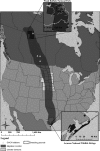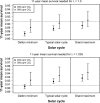Are whooping cranes destined for extinction? Climate change imperils recruitment and population growth
- PMID: 28428872
- PMCID: PMC5395435
- DOI: 10.1002/ece3.2892
Are whooping cranes destined for extinction? Climate change imperils recruitment and population growth
Abstract
Identifying climatic drivers of an animal population's vital rates and locating where they operate steers conservation efforts to optimize species recovery. The population growth of endangered whooping cranes (Grus americana) hinges on juvenile recruitment. Therefore, we identify climatic drivers (solar activity [sunspots] and weather) of whooping crane recruitment throughout the species' life cycle (breeding, migration, wintering). Our method uses a repeated cross-validated absolute shrinkage and selection operator approach to identify drivers of recruitment. We model effects of climate change on those drivers to predict whooping crane population growth given alternative scenarios of climate change and solar activity. Years with fewer sunspots indicated greater recruitment. Increased precipitation during autumn migration signified less recruitment. On the breeding grounds, fewer days below freezing during winter and more precipitation during breeding suggested less recruitment. We predicted whooping crane recruitment and population growth may fall below long-term averages during all solar cycles when atmospheric CO2 concentration increases, as expected, to 500 ppm by 2050. Species recovery during a typical solar cycle with 500 ppm may require eight times longer than conditions without climate change and the chance of population decline increases to 31%. Although this whooping crane population is growing and may appear secure, long-term threats imposed by climate change and increased solar activity may jeopardize its persistence. Weather on the breeding grounds likely affects recruitment through hydrological processes and predation risk, whereas precipitation during autumn migration may influence juvenile mortality. Mitigating threats or abating climate change should occur within ≈30 years or this wild population of whooping cranes may begin declining.
Keywords: LASSO; atmospheric CO2; boreal pond; decadal cycle; groundwater; precipitation; reproduction; solar activity; sunspots.
Figures






Similar articles
-
Optimal population prediction of sandhill crane recruitment based on climate-mediated habitat limitations.J Anim Ecol. 2015 Sep;84(5):1299-310. doi: 10.1111/1365-2656.12370. Epub 2015 May 18. J Anim Ecol. 2015. PMID: 25808951
-
Migrating Whooping Cranes avoid wind-energy infrastructure when selecting stopover habitat.Ecol Appl. 2021 Jul;31(5):e02324. doi: 10.1002/eap.2324. Epub 2021 Apr 7. Ecol Appl. 2021. PMID: 33682273
-
Haemosporida prevalence and diversity are similar in endangered wild whooping cranes (Grus americana) and sympatric sandhill cranes (Grus canadensis).Parasitology. 2017 Apr;144(5):629-640. doi: 10.1017/S0031182016002298. Epub 2016 Dec 12. Parasitology. 2017. PMID: 27938437 Free PMC article.
-
Whooping crane use of riverine stopover sites.PLoS One. 2019 Jan 9;14(1):e0209612. doi: 10.1371/journal.pone.0209612. eCollection 2019. PLoS One. 2019. PMID: 30625185 Free PMC article.
-
Pathology and pathogenesis of disseminated visceral coccidiosis in cranes.Avian Pathol. 2004 Jun;33(3):275-80. doi: 10.1080/0307945042000203371. Avian Pathol. 2004. PMID: 15223553 Review.
Cited by
-
Geomagnetic disturbance associated with increased vagrancy in migratory landbirds.Sci Rep. 2023 Jan 9;13(1):414. doi: 10.1038/s41598-022-26586-0. Sci Rep. 2023. PMID: 36624156 Free PMC article.
-
Whooping Crane Chick Survival in the Reintroduced Eastern Migratory Population.Ecol Evol. 2025 Apr 25;15(4):e71284. doi: 10.1002/ece3.71284. eCollection 2025 Apr. Ecol Evol. 2025. PMID: 40290382 Free PMC article.
-
The effect of climate legacies on extinction dynamics: A systematic review.Camb Prism Extinct. 2025 Mar 17;3:e6. doi: 10.1017/ext.2025.2. eCollection 2025. Camb Prism Extinct. 2025. PMID: 40160844 Free PMC article. Review.
References
-
- Akçakaya, H. R. , Butchart, S. H. M. , Watson, J. E. M. , & Pearson, R. G. (2014). Commentary: Preventing species extinctions resulting from climate change. Nature Climate Change, 4, 1048–1049.
-
- Brown, W. M. , & Drewien, R. C. (1995). Evaluation of two power line markers to reduce crane and waterfowl collision mortality. Wildlife Society Bulletin, 23, 217–227.
-
- Butler, M. J. , Harris, G. , & Strobel, B. N. (2013). Influence of whooping crane population dynamics on its recovery and management. Biological Conservation, 162, 89–99.
-
- Butler, M. J. , Metzger, K. L. , & Harris, G. (2014). Whooping crane demographic responses to winter drought focus conservation strategies. Biological Conservation, 179, 72–85.
LinkOut - more resources
Full Text Sources
Other Literature Sources

